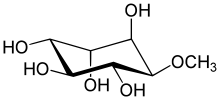Quebrachitol
 | |
| Names | |
|---|---|
IUPAC name (1R,2S,4S,5R)-6-methoxycyclohexane-1,2,3,4,5-pentol | |
| Other names Quebrachitol L-Quebrachitol (-)-Quebrachitol 2-O-methyl-l-inositol 2-0-methyl-chiro-inositol | |
| Identifiers | |
CAS Number |
|
3D model (JSmol) |
|
ChEMBL |
|
ChemSpider |
|
PubChem CID |
|
InChI
| |
SMILES
| |
| Properties | |
Chemical formula | C7H14O6 |
Molar mass | 194.18 g/mol |
| Appearance | White to off-white powder |
Melting point | 190 to 198 °C (374 to 388 °F; 463 to 471 K) |
Solubility in water | Soluble in DMSO, dimethyl formamide, or water |
Except where otherwise noted, data are given for materials in their standard state (at 25 °C [77 °F], 100 kPa). | |
Infobox references | |
Quebrachitol is a naturally occurring optically active cyclitol, a cyclic polyol. It can be found in Allophylus edulis[1] and in the serum left after the coagulation of the Hevea brasiliensis latex in the operation of rubber tapping.[2] It is also found in Cannabis sativa,[3] in Paullinia pinnata and in seabuckthorn.[4]
It was first isolated by Tanret in 1887 from the bark of Aspidosperma quebracho. The substance was tested as a sweetening agent for diabetics in 1933. It shows a sweetening property half of that of sucrose but induces colic or diarrhoea at concentration used to render the food palatable.[5]
Quebrachitol is a versatile building block in the construction of naturally occurring bioactive materials.[6] For example, its conversion into antifungal (E)-β-methoxyacrylate, oudemansin X has been made.[7]
References
^ First record of l-quebrachitol in Allophylus edulis (Sapindaceae). Martina Díaz, Andrés González, Ian Castro-Gamboa, David Gonzalez and Carmen Rossini, Carbohydrate Research, Volume 343, Issue 15, 13 October 2008, Pages 2699-2700, doi:10.1016/j.carres.2008.07.014
^ van Alphen, Jan (1951). "Quebrachitol". Industrial & Engineering Chemistry. 43: 141–145. doi:10.1021/ie50493a041..mw-parser-output cite.citation{font-style:inherit}.mw-parser-output .citation q{quotes:"""""""'""'"}.mw-parser-output .citation .cs1-lock-free a{background:url("//upload.wikimedia.org/wikipedia/commons/thumb/6/65/Lock-green.svg/9px-Lock-green.svg.png")no-repeat;background-position:right .1em center}.mw-parser-output .citation .cs1-lock-limited a,.mw-parser-output .citation .cs1-lock-registration a{background:url("//upload.wikimedia.org/wikipedia/commons/thumb/d/d6/Lock-gray-alt-2.svg/9px-Lock-gray-alt-2.svg.png")no-repeat;background-position:right .1em center}.mw-parser-output .citation .cs1-lock-subscription a{background:url("//upload.wikimedia.org/wikipedia/commons/thumb/a/aa/Lock-red-alt-2.svg/9px-Lock-red-alt-2.svg.png")no-repeat;background-position:right .1em center}.mw-parser-output .cs1-subscription,.mw-parser-output .cs1-registration{color:#555}.mw-parser-output .cs1-subscription span,.mw-parser-output .cs1-registration span{border-bottom:1px dotted;cursor:help}.mw-parser-output .cs1-ws-icon a{background:url("//upload.wikimedia.org/wikipedia/commons/thumb/4/4c/Wikisource-logo.svg/12px-Wikisource-logo.svg.png")no-repeat;background-position:right .1em center}.mw-parser-output code.cs1-code{color:inherit;background:inherit;border:inherit;padding:inherit}.mw-parser-output .cs1-hidden-error{display:none;font-size:100%}.mw-parser-output .cs1-visible-error{font-size:100%}.mw-parser-output .cs1-maint{display:none;color:#33aa33;margin-left:0.3em}.mw-parser-output .cs1-subscription,.mw-parser-output .cs1-registration,.mw-parser-output .cs1-format{font-size:95%}.mw-parser-output .cs1-kern-left,.mw-parser-output .cs1-kern-wl-left{padding-left:0.2em}.mw-parser-output .cs1-kern-right,.mw-parser-output .cs1-kern-wl-right{padding-right:0.2em}
^ 1955 - ACTA UNIVERSITATIS PALACKIANAE OLOMUCENSIS - TOM. VI. - HEMP AS A MEDICAMENT, Properties of isolated substances. Prof. Jan Kabelik, A brief survey of the methods of isolation and the physical and chemical properties and structures of the isolated antibacterial substances. F. Santavy & Z. Krejci
^ Some new data about antiviral and related activities of seabuckthorn principals and the prospects of their use. Shipulina L.D., All-Russian Research Institute of Medicinal and Aromatic Plants, Moscow, Russia
^ McCance, RA; Lawrence, RD (1933). "An investigation of quebrachitol as a sweetening agent for diabetics". Biochem J. 27 (4): 986–9. doi:10.1042/bj0270986. PMC 1252976. PMID 16745234.
^ Kiddle, James J. (1995). "Quebrachitol: A Versatile Building Block in the Construction of Naturally Occurring Bioactive Materials". Chemical Reviews. 95 (6): 2189–2202. doi:10.1021/cr00038a016.
^ Total synthesis of antibiotic (−)-oudemansin X utilizing L-quebrachitol as a chiral pool. Chida N., Yamada K. and Ogawa S., Chemistry Letters, 1992, no4, pp. 687-690
External links
| Look up quebrachitol in Wiktionary, the free dictionary. |
Quebrachitol on the Sigma-Aldrich website at the Wayback Machine (archived October 3, 2012)
